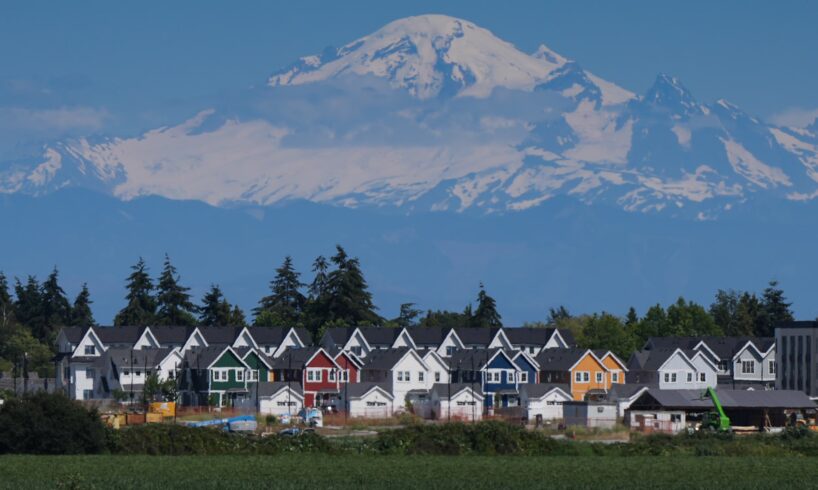
Good morning. Cities have hiked development fees on new housing projects, a tax buyers never see but have to pay – more on that below, along with a made-in-Canada generic Ozempic and Ottawa’s threats to sue automaker Stellantis. But first:
Today’s headlinesOpen this photo in gallery:
A nice bumper crop of Delta, B.C., homes.DARRYL DYCK/The Canadian Press
HousingMunicipal markups
It is a truth universally acknowledged that Canada needs stacks of new housing. Federal leaders may disagree on the cause of this crisis: Prime Minister Mark Carney blames bureaucratic hurdles, weak domestic supply chains and not enough prefab units; Conservative Leader Pierre Poilievre blames the Liberal government. Either way, homes remain prohibitively expensive for many prospective buyers. Even with the peak real-estate madness of early 2022 behind us, the average home price in Canada hovers around $700,000. In Vancouver and Toronto, it’s more than $1-million.
The federal government is trying to double housing construction, doling out an initial $13-billion in funding to its newly launched agency, Build Canada Homes. But Ottawa is up against some serious headwinds. Housing starts are down and poised to fall further: In July, Canada Mortgage and Housing Corp. forecast 220,000 starts for 2027, a drop of roughly 50,000 units from 2021. Also, somebody actually has to build all these homes, and tradespeople are ditching the industry. Last week, Deloitte reported the country will be short half a million workers in the next five years to meet Carney’s ambitious goals.
It’s not great! But there’s another sneaky matter holding back new construction. Across the country, cities have jacked up their development charges – fees ostensibly paid by builders to fund local infrastructure, but pretty much always passed on to buyers instead. And these charges can end up adding six figures to the cost of a home.
Charge it
The argument for development charges goes like this: New growth should pay for new growth. Building booms put extra pressure on roads, transit, sewers, water systems and other public services, so developers need to shell out for those costs. B.C. started allowing the levies in 1958, as cities struggled with postwar housing spurts, and Ontario codified them in 1997 with the Development Charges Act. The two provinces now have the highest fees in the country. According to the Canadian Home Builders’ Association, development charges rose 700 per cent over the past 25 years.
That means, in Vancouver, a full $119,000 of the average new home cost can be chalked up to these charges. In Toronto, it’s $138,000, and in Markham, Ont., it’s worse: $160,000. Home builders complain that cities treat development charges like a bottomless piggy bank, hiking fees to avoid raising property taxes or to fund infrastructure used by new and existing residents alike. Anybody buying a new build in Toronto, for example, has to cough up thousands for the Spadina subway extension – which opened eight years ago.
Open this photo in gallery:
Canada will need half a million more of these construction workers soon.Fred Lum/the Globe and Mail
And since housing is all about comparison shopping, the ballooning price of new builds can push up the entire market. But mayors argue that they’re compelled to lean on the charges, because provincial and federal governments don’t provide anywhere near enough money to cover the costs of growth. “Somebody’s got to pay,” said Mayor Mike Hurley of Burnaby, B.C. (development fees: $66,000). “And they just keep downloading onto us.”
Cut it out
It’s fair if you aren’t familiar with these charges: Toronto developer Brandon Donnelly has described them as “a tool to transfer costs away from people who don’t want to pay for stuff to people who don’t know they’re paying for stuff.” Development fees are absorbed by the price of a home, which means they aren’t broken out into separate line items such as HST or land transfer tax. In fact, they’re actually subject to HST and land transfer tax, creating a whole tax-on-tax situation.
One solution, then, is to treat development fees like those line items, charged directly to buyers rather than hidden in the final cost of a new home. Canadian economist Mike Moffat suspects this transparent system could save buyers tens of thousands of dollars, much of it ultimately covered by government, developers and big banks.
Another option, of course, is for cities to rein in the fees. In Ontario, Mississauga and Vaughan both voted recently to slash their development charges, while Toronto froze its levies earlier this year. And if cities are disinclined to start cutting, the federal government could get the job done for them: Build Canada Homes includes a commitment to halve development charges for multiunit housing. Ottawa hasn’t yet offered details on how it’ll do that while maintaining municipal infrastructure funding, but maybe more will be revealed in November’s federal budget. As Burnaby’s mayor knows very well, somebody’s got to pay.
The Shot‘We will act in the interests of all Canadians.’Open this photo in gallery:
An assembly line at the Stellantis plant in Brampton, Ont.Chris Young/The Canadian Press
The federal government is threatening to sue automaker Stellantis over its move to make the Jeep Compass in Illinois instead of Brampton, Ont., as part of a US$13-billion plan to boost production in the U.S. Read more about Industry Minister Mélanie Joly’s warning here.
The WrapWhat else we’re following
At home: The Progressive Conservatives won a slim majority over the incumbent Liberals in Newfoundland and Labrador’s provincial election.
Abroad: A U.S. judge temporarily blocked the Trump administration from firing workers during the government shutdown, saying the cuts seemed politically motivated.
A coup: Madagascar’s new military ruler will be sworn in as the country’s president on Friday, after ousting President Andry Rajoelina earlier this week.
A plan: The CBC has unveiled a five-year strategy for winning back its audience, especially in rural areas and Western Canada.
Health: As the race heats up to deliver a generic form of Ozempic next year, Vimy Pharma aims to produce a made-in-Canada version.
Snacks: I am not convinced by Miss Vickie’s new take on cacio e pepe, but your potato-chip mileage may vary.





